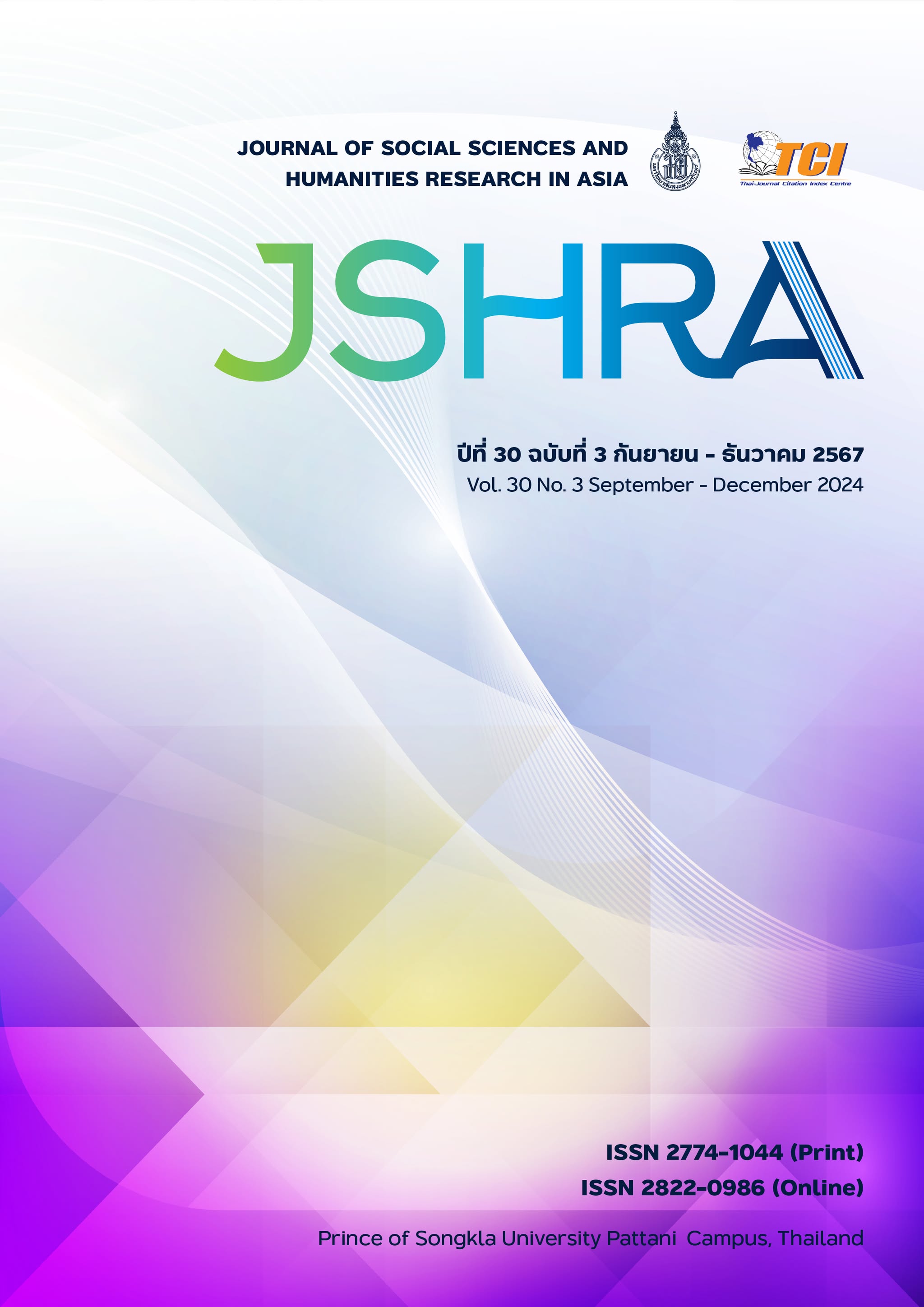Differences in Motivations of Online Gamers
Keywords:
Game Addiction, Motivation, Online GamersAbstract
This research aims to study gaming motivations of gamers and to compare the gaming motivations among regular gamers, at-risk gamers, and addicted gamers within the Thai online gaming community, aged between 18 and 60 years. The sample consisted of 313 individuals, selected through convenience sampling. The research instruments included the Trojan player typology questionnaire and game addiction screening test. Personal data were analyzed using descriptive statistics, and differences between groups were analyzed by Kruskal-Wallis test. The results indicated that the motivations related to story-driven were high for both regular gamers and addicted gamers ( = 3.84, S.D. = .892 and
= 3.71, S.D. = .795, respectively). The risk gamers exhibited the highest level of motivation related to achievement (
= 3.82, S.D. = .753). Overall, the study found that competitive motivation significantly differed among the various levels of gaming addiction at .05 significance level. Additionally, there was a significant difference in challenge motivation between regular gamers and addicted gamers at the .05 significance level, while no significant differences were found between other groups.
References
American Psychiatric Association. (2013). Diagnostic and statistical manual of mental disorders: DSM-5. 5th ed. Washington, D.C.: American Psychiatric Association.
Anh, P. Q. (2021). Shifting the focus to East and Southeast Asia: A critical review of regional game research. Fudan Journal of the Humanities and Social Sciences, 14(2), 173-196. https://doi.org/10.1007/s40647-021-00317-7
Apisitwasana, N. (2015). Development of Self-Regulation on Gaming Addiction by a Participatory Learning School and Family-based Intervention Program among Grade 4-5 Students in Bangkok Thailand. (Doctoral dissertation, Chulalongkorn University).
Bandura, A. (1969). Social-learning theory of identificatory processes. Handbook of socialization theory and research, 213, 262.
Bartle, R. (1996). Hearts, clubs, diamonds, spades: Players who suit MUDs. Journal of MUD research, 1(1), 19.
Bormann, D., & Greitemeyer, T. (2015). Immersed in virtual worlds and minds: effects of in-game storytelling on immersion, need satisfaction, and affective theory of mind. Social Psychological and Personality Science, 6(6), 646-652. https://doi.org/10.1177/194855061557817
Charoenwanit, S., & Sumneangsanor, T. (2014). Predictors of game addiction in children and adolescents. Thammasat Review, 17(1), 150-166.
Cruz, C., Hanus, M. D., & Fox, J. (2017). The need to achieve: Players' perceptions and uses of extrinsic meta-game reward systems for video game consoles. Computers in Human Behavior, 71, 516-524. https://doi.org/10.1016/j.chb.2015.08.017
Entertainment Software Association. (2019). 2019 essential facts about the computer and video game industry. Retrieved February 15, 2021, from https://www.theesa.com/esaresearch/2019-essential-facts-about-the-computer-and-video-game-industry/
Faul, F., Erdfelder, E., Buchner, A., & Lang, A.-G. (2009). Statistical power analyses using G*Power 3.1 : Tests for correlation and regression analyses. Behaviour Research Methods, 41(4), 1149-1160. https://doi.org/10.3758/BRM.41.4.114911.
Gough, C. (2020). Age breakdown of video game players in the United State in 2020. Statista. Retrieved August 28, 2020, from https://www.statista.com/statistics/189582/age-of-usvideo-game-players-since-2010/
Hainey, T., Connolly, T., Stansfield, M., & Boyle, E. (2011). The differences in motivations of online game players and offline game players: A combined analysis of three studies at higher education level. Computers & Education, 57(4), 2197-2211. https://doi.org/10.1016/j.compedu.2011.06.001
Kahn, A. S., Shen, C., Lu, L., Ratan, R. A., Coary, S., Hou, J., ... & Williams, D. (2015). The trojan player typology: A cross-genre, cross-cultural, behaviorally validated scale of video game play motivations. Computers in Human Behavior, 49, 354-361. https://doi.org/10.1016/j.chb.2015.03.018
Kiatrungrit, K. (2020). “Game addiction” threats endangering Thai children (Part 1). Thairath Online. Retrieved August 28, 2020, from https://www.thairath.co.th/lifestyle/life/1368725
Kshetri, N. (2009). The evolution of the Chinese online gaming industry. Journal of Technology Management in China, 4(2), 158–179. https://doi.org/10.1108/17468770910965019
Kuss, D. J., & Griffiths, M. D. (2012). Internet gaming addiction: A systematic review of empirical research. International Journal of Mental Health and Addiction, 10, 278-296. https://doi.org/10.1007/s11469-011-9318-5
Lee, J., Lee, M., & Choi, I. H. (2012). Social network games uncovered: Motivations and their attitudinal and behavioral outcomes. Cyberpsychology, Behavior, and Social Networking, 15(12), 643-648. https://doi.org/10.1089/cyber.2012.0093
Martins, D., Zagalo, N., & Oliveira, A. P. (2023). Motivation and flow experience as crucial factors in the completion of narrative games. Digital Games Research Association. Seville, Spain.
Maslow, A. H. (1958). A dynamic theory of human motivation. In C. L. Stacey & M. DeMartino (Eds.), Understanding human motivation (pp. 26–47). Howard Allen Publishers. https://doi.org/10.1037/11305-004
Petry, N. M., Rehbein, F., Ko, C. H., & O’Brien, C. P. (2015). Internet gaming disorder in the DSM5. Current Psychiatry Reports, 17(9), 72. https://doi.org/10.1007/s11920-015-0610-0
Pornnoppado, C., Sornpaisarn, B., Kamkliang, K., & Pattana-amorn, S. (2014). Developing game addiction screening test. The Journal of the Psychiatric Association of Thailand, 59(1), 3-14.
Quwaider, M., Alabed, A., & Duwairi, R. (2019). The impact of video games on the players behaviors: A survey. Procedia Computer Science, 151, 575-582. https://doi.org/10.1016/j.procs.2019.04.077
Samangkul, S., Wiboonsawat, P., Buroksikon, D., Teeranate, N., Chaowasin, S., & Channuan, N. (2009). General psychology. Handbook Project, Chiang Mai University. Research Promotion and Handbook Division, Office of Educational Services, Chiang Mai University. Department of Psychology, Faculty of Humanities, Chiang Mai University. (8th ed.).
Sherry, J. L., Lucas, K., Greenberg, B. S., & Lachlan, K. (2006). Video game uses and gratifications as predictors of use and game preference. Playing Video Games: Motives, Responses, and Consequences, 24(1), 213-224.
Slattery, J., Romkey, I., & Yakovenko, I. (2023). Impulsivity and video game–related motives as predictors of video game loot box use. Canadian Journal of Addiction, 14(3), 43–51. https://doi.org/10.1097/CXA.0000000000000183
Thailand E-Sports Federation (TESF). (2021). Main website. Retrieved February 11, 2021, from https://tesf.or.th/about/
Wan, C. S., & Chiou, W. B. (2007). The motivations of adolescents who are addicted to online games: a cognitive perspective. Adolescence, 42(165), 179–197.
Wittek, C. T., Finserås, T. R., Pallesen, S., Mentzoni, R. A., Hanss, D., Griffiths, M. D., & Molde, H. (2016). Prevalence and predictors of video game addiction: A study based on a national representative sample of gamers. International Journal of Mental Health and Addiction, 14, 672-686. https://doi.org/10.1007/s11469-015-9592-8
Yang, J., Wang, R., Cook, A., & Fuller, R. (2023). Gaming during the COVID-19 pandemic: Examining its effect on loneliness & motivation, playing and gratification differences between competitive and recreational gamers. Telematics and Informatics Reports, 11, 100093. https://doi.org/10.1016/j.teler.2023.100093
Yee, N. (2006). Motivations for play in online games. CyberPsychology & Behavior, 9(6), 772-775. https://doi.org/10.1089/cpb.2006.9.772
Zhong, Z. J., & Yao, M. Z. (2013). Gaming motivations, avatar-self identification and symptoms of online game addiction. Asian Journal of Communication, 23(5), 555-573. https://doi.org/10.1080/01292986.2012.748814











